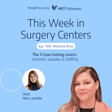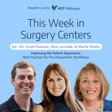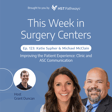Become a Creator today!Start creating today - Share your story with the world!
Start for free
00:00:00
00:00:01

Staffing: Locum, Contract, or Permanent?
In the final episode of our Staffing Strategies series, Maddie Traylor, President of AdvancedScope, joins us to explore the differences between locum, contract, and permanent hires. We dive into the pros and cons of each staffing model and how surgery centers can determine the best fit based on their unique needs.
After the conversation with Maddie, stick around for our Data & Insights segment. We’ll take a few minutes to unpack one of the key takeaways from HST’s 2024 State of the Industry report: average recovery times by specialty, based on data from 590 surgery centers.
Resources Mentioned:
- HST’s State of the Industry Report: https://www.hstpathways.com/resources/surgery-center-industry-report/
- The National Library of Medicine’s report on aromatherapy's role in decreasing PONV: https://pubmed.ncbi.nlm.nih.gov/34905993/
Brought to you by HST Pathways.
Transcript
Podcast Introduction and Format Overview
00:00:01
Speaker
Welcome to This Week in Surgery Centers. If you're in the ASC industry, then you're in the right place. Every week, we'll start the episode off by sharing an interesting conversation we had with our featured guest.
00:00:12
Speaker
And then we'll close the episode by recapping the latest news impacting surgery centers. We're excited to share with you what we have. So let's get started and see what the industry's been up to.
Staffing Strategies for ASCs with Maddie Traylor
00:00:28
Speaker
Hi everyone, here's what you can expect on today's episode. Maddie Traylor, president of Advanced Scope, joins us today to wrap up our third and final episode of our staffing strategy series.
00:00:40
Speaker
We've already covered how to choose the best staffing agency and how to build a sustainable culture. So today with Maddie, we'll discuss the differences, pros and cons of locum contract and permanent hires.
00:00:52
Speaker
After my conversation with Maddie, we'll switch to our data and insights segment. HST released our annual State of the Industry report in September, which analyzed client data from 590 surgery centers.
00:01:04
Speaker
Today, we'll spend a few minutes breaking down average recovery times per specialty. Hope everyone enjoys the episode, and here's what's going on this week in surgery centers.
00:01:17
Speaker
Hi, Maddie. Welcome to the podcast. Hi. Thank you so much for having me. Can you please share a little bit about yourself with our listeners? Sure. Yeah. This is always my my worst part, but my name is Maddie Traylor.
00:01:31
Speaker
i own a recruiting firm called Advanced Scope, and I work in HR with consulting and primarily with private practices and ASC's. Very cool. So you are actually wrapping up our three-part series on staffing strategies. So far, we've covered tips for selecting the best staffing agency, how to build a sustainable culture in order to retain the staff you do have.
00:01:55
Speaker
And today with you, we'll be covering different types of staffing arrangements. So when it comes to physicians and staffing, what hiring models do ASCs have to choose from?
Exploring Staffing Models: Locum, Contract, Permanent
00:02:07
Speaker
Sure. It's a great question. So really there's three different models that you can go with. Two are somewhat similar in that they're more contract. So when you're working with an agency, a lot of times what you might see is either on the locum side or on the contract side, that agency would actually employ the physician or the provider themselves, and they would offer them different benefits. And then they charge you essentially a margin in between what they're paying the provider and then what they're charging you for that provider.
00:02:36
Speaker
So typically that markup is anywhere from 30 to sometimes 50%, which is quite crazy, but they make good money doing that. And that is the nature of that side of things. And there's definitely a time and place for it.
00:02:50
Speaker
And then you also have direct hire recruitment or permanent recruitment, which is more so that someone like myself, a headhunter would go find the candidate, bring them to you and you would hire them directly onto your team.
00:03:02
Speaker
So that provides for a few different benefits, but there's again, a time and a place for each of those. Sure. And what are the pros and cons of each? Yeah, so on the staffing side, I'll group those as contract and locum, is that those folks, you can probably reach out to an agency and get somebody to start working within in a few days, sometimes even the next day. So if you are seeing ah coverage issue, right, you have a gap in your provider care, or you have patient waiting lists, and you really just need to get somebody in place, and or a super specialized role. So you think people like CRNAs, most of the time they're doing locums in their contract.
00:03:42
Speaker
That is a huge perk to that is that if you need someone right away, you want to turn to that route versus, you know, seeing people go to your competitors. The cons to that is that It is 30% higher on average for a locums provider rather than that of a permanent or direct hire.
00:04:01
Speaker
Reason being is that those staffing firms are having to make money on providing you that person and employing them. And so they're charging you a larger margin than that of what you would pay in a flat fee and or a percentage of salary when it comes to the permanent direct hire side.
Proactive Recruitment Strategies for ASCs
00:04:18
Speaker
The other key thing to think about is just continuity of care when you're looking at permanent recruitment. so NASCs, if you're a private practice and you're handling complex surgeries and or just wanting to make sure that your patients feel like they have that touch point with you and that relationship and trust, then you want to have continuity to where someone's not there one day and then gone the next.
00:04:43
Speaker
Sure. So let's say maybe you have someone on staff or maybe it's the holidays and you know around December and you know you're going to be super busy or someone's going on vacation. Maybe we're using locum hires in that instance.
00:04:58
Speaker
Or if you have someone who's maybe going on parental leave, then we're looking at contract because it'll be a little bit longer. Right. Okay. Exactly.
00:05:09
Speaker
and There's different ways that you can go about it. I think if you're proactive in your approach and you budget and forecast for things, then you don't have to have that spend when it comes to contract to hire locums because it is typically way more expensive.
00:05:21
Speaker
The benefit is that you're getting a provider right away, whereas on the permanent side, likely it's going to take a little bit more time because that person is going to be long-term employed with you. Gotcha.
00:05:33
Speaker
So what long-term staffing strategies can ASCs implement to avoid constantly having to operate in reaction mode when it comes to hiring?
00:05:44
Speaker
Yeah, that's a great question because 99% of practices do act in reactive mode. And I think it boils down to having great process in place and also budgeting and forecasting for your hiring needs. So what that looks like is, you know, it's not rocket science. We all do it.
00:06:02
Speaker
but actually having a process behind it, whether that's saying every quarter we're going to sit down with the partners and going to sit down with an operational leader, maybe somebody that's an ASC administrator to say, here's what we you know anticipate in terms of volume, or maybe we want to add a new specialty to the surgery center.
00:06:20
Speaker
How are we going to go about that and find the right people? And what can we do right now to help us not be just in that reactive mode? So That boils down to performance management strategies, who are top performers, who can we train up rather than you know out from a retention standpoint, who can we try to pipeline and network with now so that six months from now we have the right people that want to talk to us, who want to join our team.
00:06:47
Speaker
And really it boils down to being well-prepared rather than being lucky and or thinking that if I need someone tomorrow, I can post the job on Indeed today. Yeah, I was talking to someone it was probably about a year ago now, and they were saying how pre-COVID they would post a job on Indeed and they would get, you know, 30 to 40 applicants and they'd go through their process and they were really in the driver's seat.
00:07:11
Speaker
And now post-COVID, it's crazy five years later, we're still talking about it, but, you know, they would post the same job posting and get one or two responses if they were lucky, which is just wild. Yeah.
00:07:26
Speaker
And even those responses, I've heardd that i've heard from most of my clients that they're not of the same quality. A lot of times they're not even coming from the same specialty or a lot of times it's new grads rather than experienced or specialized people.
00:07:40
Speaker
And i will say that, you know, no matter what route you go, there's money outlay, right? And I think that's the biggest hurdle is that everyone wants to do it themselves. But No matter which way you go about it, there's going to be you've got to spend money to make money.
Impact of Various Factors on Recruitment Strategies
00:07:56
Speaker
And as long as you're finding the right people, then those providers, those doctors are going to make the practice profit. Sure. And what are the biggest challenges for ASCs?
00:08:08
Speaker
What do they face in recruiting top talent? Yeah. So I'll start with on the locum side. I see a lot of people misunderstanding the backgrounds of recruitment. And so I'll explain this in the best way can without trying to come across as pushing one way or the other.
00:08:25
Speaker
But, you know, think about it like this, a staffing recruiter, somebody that's working with contractors and or locums providers, they are constantly looking for that person's next best step, right? And where they can get that better margin. Right.
00:08:39
Speaker
So if they find another practice that's willing to hire that contractor at a higher rate and they can keep the contractor at the same rate as what they're working at, they're going to try to push them into that next opportunity. So even if you wanted to renew that person from a continuity of care standpoint,
00:08:57
Speaker
it likely won't happen because that recruiter has already found them their next placement because they get paid and commission off of that bill rate and the margin in between it. And so this is something to keep in mind. And that's been a huge challenge for people that are using locums or contract or specialized hiring versus that of direct hire.
00:09:18
Speaker
On the direct hire front, though, the biggest issue is that You're competing with hospitals that oftentimes offer better and bigger benefits and bigger salaries up front.
00:09:29
Speaker
And so it's getting wise about what does your culture look like? You know, how are we retaining talent? How are we creating a space where people want to stay even if they have the opportunity to leave?
Long-term Recruitment Investment and Efficiency
00:09:40
Speaker
And what are we doing different as an employer to make people feel valued? Yeah, for sure. i know one of my good friends was a travel nurse for a long time and she was on the hospital side. And I just, I learned so much about how important the culture is watching her go from contract to contract. You know, there were some, sometimes she'd get, and this is in a hospital setting, so a little different, but she would get to a facility and they would be so grateful for her help that they just treated her so well. She got to choose her own schedule all, you know, and then she'd get to a different setting and they,
00:10:16
Speaker
knew she was probably making a little bit more and they were not very welcoming to her. And, you know, she worked nights and she'd be on off and I'm like, and, you know, and she would never return. Whereas to some of the other facilities because of the culture, she was happy to return.
00:10:33
Speaker
Exactly. I think it is, it boils down to your culture, how you treat your people, because, you know, if you take care of your people, they will take care of the patients. Sure.
00:10:44
Speaker
And how do factors like case mix, payer mix, and location impact recruitment strategies?
00:10:52
Speaker
Yeah. so I think those are all important things to think about when it comes to the hiring process. You know, when you look at case mix, you want to understand your complexity. And so If you are doing super complex procedures, then you can't just hire somebody that is coming out of fellowship with no other mentor, collaborating surgeon or doctor.
00:11:12
Speaker
You can't hire new grads, you know, and that's something to think about is maybe you can if you have the training and people there to create that bandwidth. But for the most part, then you're going to spend more on your providers and who you're hiring because they're experienced and specialized, whereas If you're an ASC that's focused more on the efficiency and volume side, you want to make sure that you have the people in place who understand that and that approach and can handle that high volume rather than that of the complexities.
00:11:42
Speaker
When it comes to payer mix, it really boils down to how much Medicare Medicaid are you doing, knowing that there's a lower reimbursement rate. You can't pay your providers as much. So if that's the route that you're taking or that's the patient population you're seeing,
00:11:56
Speaker
You have to be wise about how much you're paying the providers. And maybe they're being more so of like an incentive than that of a higher today salary or some type of model that keeps them there outside of the pay, like your culture, the growth opportunity, the learning opportunity.
00:12:13
Speaker
And then finally, I think location, it's key to keep in mind that if you are in a huge city, you're up against probably large hospital systems who are throwing money at them. Up front, that's going to be way more than what you're going to pay as a private practice or ASC.
00:12:28
Speaker
So again, like what other perks do you have, right? is there a partnership option? Is there buy-in to the ASC? If you're in a rural area, you know, thinking about sign-on bonuses and student loan reimbursements, things that incentivize and will attract people to come and choose to work for you rather than, you know, working for the big name hospital around the corner.
00:12:52
Speaker
Yeah. I like the student loan buyout. I haven't heard that one yet. and That's a good one. I wish I had a physician, but... I know. All right. We do this every week with our guests. What is one thing our listeners can do this week to improve their surgery centers?
00:13:11
Speaker
Yes. So I'm going to come at this more from a business standpoint because that's the side that I'm on in that I think a lot of people i hear are afraid to spend money to make money, whether it be hiring the right provider for more money.
00:13:24
Speaker
You really need to think about it like this, that you need to outsource things that you cannot do yourself or that cost you too much of your time. And if you are an ASC, whether you're a de novo ASC or you've been around forever, you can't get too stuck in your own ways that you're afraid to spend money on things that will ultimately lead to ah ROI, but it might take time. And that really boils down to recruiting in a whole sense and big picture is that you're never going to make back what you pay somebody, maybe even in the first couple of years when you're thinking about, you know, surgeons.
00:14:00
Speaker
But eventually you will. And you have to have that long-term mindset rather than just the upfront cost of things.
Data Insights from HSC Pathways Report
00:14:09
Speaker
That is great advice. Thank you so much for coming on and walking us through all these different options that ASCs have. Yes, of course. I appreciate you having me on.
00:14:25
Speaker
HSC Pathways released an updated version of our State of the Industry Report in September, highlighting best practices, key process steps, and KPIs for every step of the patient journey and for nearly every recurring administrative duty.
00:14:37
Speaker
Most importantly, using our own unique data set from our clients, we were able to extract data points so that anyone in the industry could compare themselves to their peers. Two quick disclaimers, we only pulled data from clients who gave us permission and we omitted any extreme outliers.
00:14:52
Speaker
So today we're taking a closer look at recovery time, one of the most critical yet often overlooked metrics in surgery centers. So why is tracking this metric so important?
00:15:03
Speaker
Recovery time impacts a lot of things, the patient experience, your OR schedule, your staffing model. So ultimately your bottom line. Let's start with the data. We looked at year-over-year recovery times and broke them out by 12 specialties, and a few things stood out.
00:15:19
Speaker
Most specialties saw improvement or at least stability, but plastic surgery still has the longest average recovery time, but did drop from 87.8 minutes in minutes in 2024.
00:15:30
Speaker
twenty twenty three to eighty four point three minutes in twenty twenty four Cardiovascular procedures saw the biggest year-over-year change and increased from 58.1 minutes in And ophthalmology, already the fastest, ended up shaving off even more time, down to just 12 and a half minutes in 2024 from 13 and a half minutes in 2023.
00:15:58
Speaker
If you'd like to see the metrics for other specialties, the link to the full State of the Industry report is in the episode notes.
Optimizing Recovery Time in ASCs
00:16:04
Speaker
Okay, so what can surgery centers do to optimize this metric without sacrificing safety or quality?
00:16:11
Speaker
Let's walk through a few key strategies. The first is to streamline your post-op protocols. So you can start by reviewing your recovery workflows and try to look at, you know, are there any steps that no longer serve a purpose or could be done more efficiently?
00:16:27
Speaker
Things like redundant paperwork can add time without adding value. The second is to reevaluate your anesthesia approach. Now, I know a lot of people are already reevaluating anesthesia just because of shortages and having a hard time staffing anesthesiologists. So maybe this can all be done at the same time if you are in that boat.
00:16:46
Speaker
But anesthesia directly impacts how quickly a patient wakes up, regains mobility, and is ready for discharge. So you can collaborate with your anesthesia team to explore techniques that reduce grogginess and side effects.
00:16:58
Speaker
The right type and dose, of course, tailored to each procedure, can shorten recovery while improving patient comfort and the patient experience. The third is to make sure you have the right size recovery room staffing.
00:17:12
Speaker
So recovery rooms need to be staffed appropriately, not just adequately. Too few staff can lead to delays, while too many can lead to inefficiencies. So use your data to determine the right staffing model for peak times and adjust accordingly.
00:17:29
Speaker
The fourth tip is to get ahead of nausea and vomiting as best you can. So post-op nausea is one of the top reasons patients stay in recovery longer than necessary. If your patients are high risk, consider proactive protocols such as pre-op anti-nausea meds.
00:17:45
Speaker
A small investment here can yield big time savings post-op. Now, the National Library of Medicine released a paper a few years ago sharing the results from a study that tested the efficacy of post-ease, it's called.
00:17:58
Speaker
It's a custom essential oil aromatherapy blend, and that and the goal is to decrease that post-op nausea and vomiting. The study had nurses provide the post-ease blend 384 times prior to administering any antiemetic drugs.
00:18:15
Speaker
And for 22% of the patients, it worked and there was no need for further intervention. The blend contains scents of lavender, peppermint, ginger, and lemon. And because of this, the study does support the use of aromatherapy to reduce post-op nausea and vomiting and minimize antiemetic use.
00:18:33
Speaker
So if you don't already, this might be something you want to keep on hand for patients. The fifth tip is to educate patients before they arrive. Part of recovery starts before the procedure.
00:18:45
Speaker
Make sure patients know what to expect after surgery, how they'll manage pain, and how they will get home. Clear discharge plans, reduce last-minute confusion, and speed up the entire process. And lastly, tracking your recovery times closely will help you keep a pulse on your internal averages,
00:19:02
Speaker
and get ahead of any trending issues.
Podcast Conclusion and Listener Engagement
00:19:05
Speaker
By taking steps to optimize this phase of the patient journey, you'll improve patient throughput, free up staff, and create a smoother, safer, more satisfying experience for everyone involved.
00:19:16
Speaker
And if you're interested in more data points and use cases, head to our website to check out the full State of the Industry report and get your hands on even more data. And that officially wraps up this week's podcast. Thank you, as always, for spending a few minutes of your week with us.
00:19:30
Speaker
Make sure to subscribe or leave a review on whichever platform you're listening from. I hope you have a great day and we will see you again next week.



















